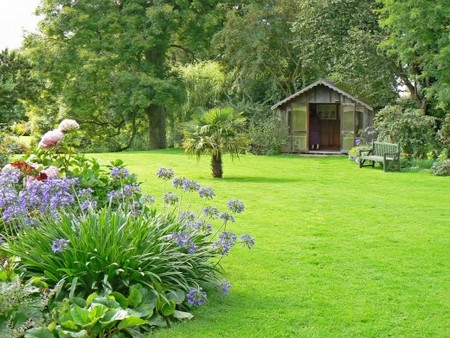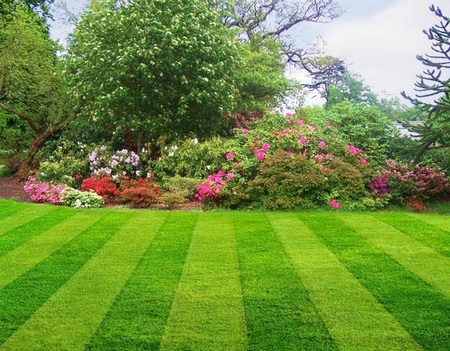A handsome lawn acts as an attractive foil for flowering and foliage plants and is usually the first feature to be noticed on entering a garden. However, it is often the most abused of all garden features, having to survive the full force of the weather and the ravages of dogs and children.
Fortunately, there are many quick and easy ways to repair what should be the emerald glory at the heart of your garden.
Ravages of dogs: Dogs have a propensity for digging holes in lawns and ripping away the surface grass, while bitches tend to urinate all over lawns, causing yellow patches wherever they go. Small holes can be treated by replacing the damaged area with a piece of fresh turf, but urine-stained, yellow areas require different treatment, although of course they too can simply be replaced with a piece of fresh grass. However, usually, it is more practical to dig out an infected area, replace it with fresh soil and then sow fresh grass seed (this is best done in spring or late summer). If the area to be treated is only a little yellow, use a garden fork to spike the ground, then repeatedly and thoroughly water the lawn. Later, apply a lawn fertilizer to the area to encourage the growth of fresh grass.
Worn, bare patches: These are often the result of too much foot traffic – or even a path in a wrong place so that people take the shortest route instead of walking by a circuitous way. Sometimes, grass can be encouraged to grow more quickly and abundantly by fencing off the bare area or placing wire-netting over it. Keeping the area moist assists grass to grow. If the soil is seriously compacted, fork it to about 15cm (6in) deep; re-firm it and sprinkle seed across the area at 50g sq. m. Lightly rake the seed into the surface, then gently but thoroughly water the area. Allow the soil to dry slightly, then cover with clear polythene; remove it when the grass is 18- 25cm high. Keep the area fenced off until the grass is well established.
Contending with tree roots: Sometimes, the roots of trees push above the lawn’s surface and interfere with grass cutting. In an informal lawn, use a strimmer to cut grass over the roots. Alternatively, in formal lawns, one solution is to form a round, raised bed flowerbed or paved area around the tree.
Dealing with weeds: Weeds will quickly take command of lawns that have been poorly prepared, created from weed-infested turf, or neglected for many years. Regular mowing, thorough watering, yearly feeding and careful scarifying will, eventually, eradicate most weeds. Weed-killing chemicals can be applied but must be used with care and consideration.
The quick way to remove lawn dew
In late summer and autumn, overnight dew sometimes sits on the grass for hours in the morning, preventing mowing until it has dried. Use a long garden cane with a whippy end to swish over the lawn’s surface and knock off the dew, encouraging the lawn to dry out quickly.
Categories
Advertisements
Recent Articles
 How to Understand Bed Sizes – A Small Guide
How to Understand Bed Sizes – A Small Guide How to Select Some Must Have Kitchen Accessories
How to Select Some Must Have Kitchen Accessories Best Way to Change a Car Tire
Best Way to Change a Car Tire Best Way to Write an Affirmation
Best Way to Write an Affirmation Best Way to Take Charge of Your Financial Life
Best Way to Take Charge of Your Financial Life Best Way to Survive a Party When You Don’t Know Anyone
Best Way to Survive a Party When You Don’t Know Anyone Best Way to Stop Self Sabotaging Yourself
Best Way to Stop Self Sabotaging Yourself Best Way to Start Journal Writing
Best Way to Start Journal Writing Best Way to Speak with a Powerful Voice
Best Way to Speak with a Powerful Voice Best Way to Simplify Your Life
Best Way to Simplify Your Life Best Way to Respond to a Put-Down
Best Way to Respond to a Put-Down Best Way to Reduce Acne Breakouts
Best Way to Reduce Acne Breakouts Best Way to Recover from Dining Disasters
Best Way to Recover from Dining Disasters Best Way to Quit Your Job Gracefully
Best Way to Quit Your Job Gracefully Best Way to Make Your Own Website
Best Way to Make Your Own Website



Leave a Reply